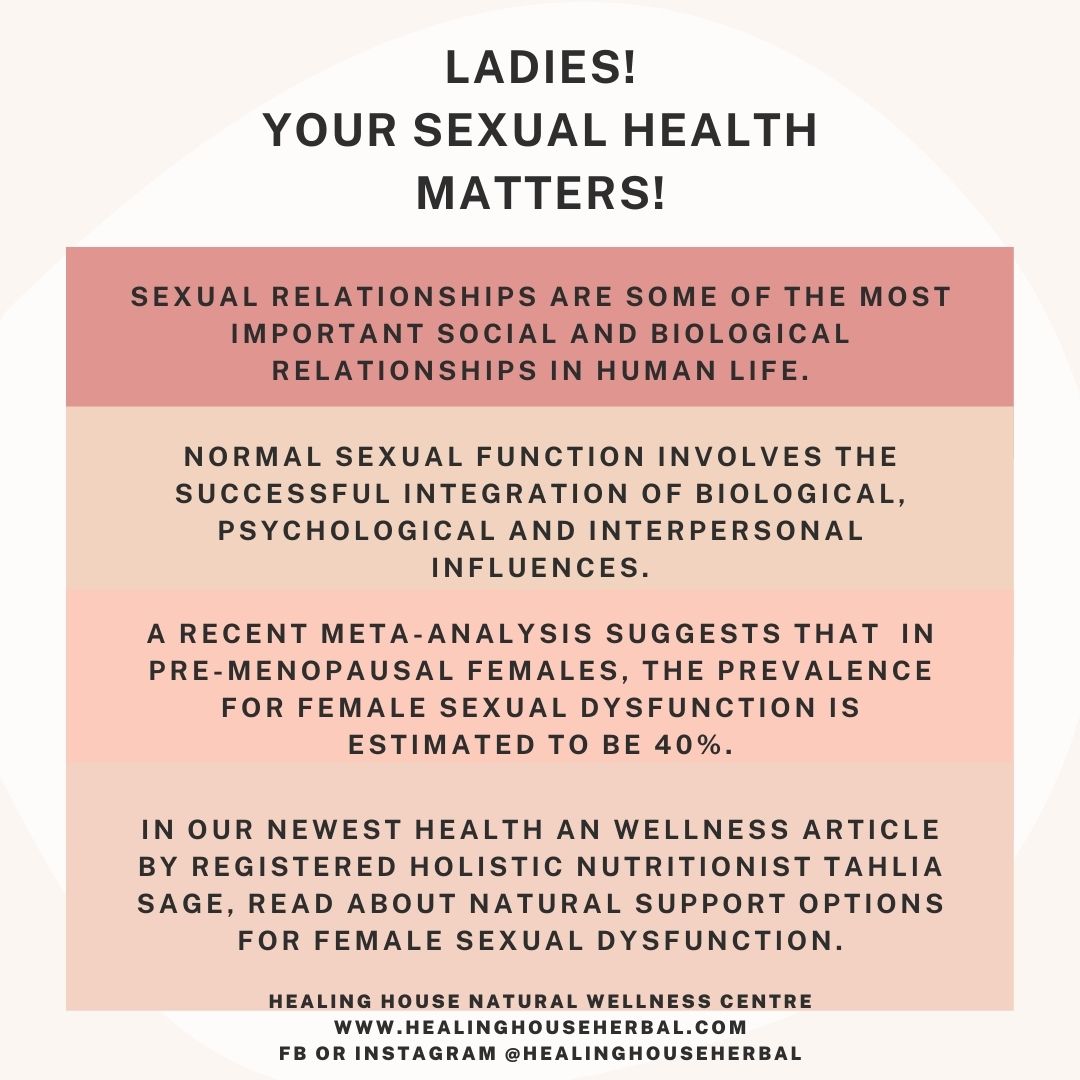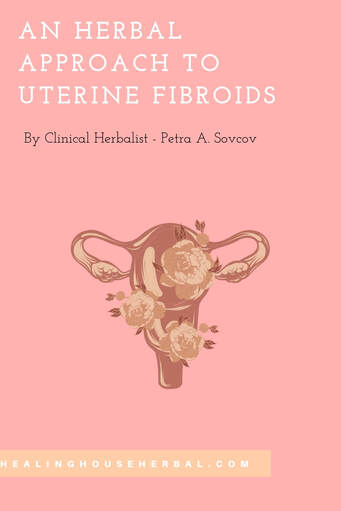|
"Sexual relationships are some of the most important social and biological relationships in human life. Next to thirst, hunger and sleep, the sexual urge is the most powerful biological drive. This physiological instinct, so essential to the survival of the species, is one of the mainsprings of human motivation, and its fulfillment or disappointment is closely related to happiness or misery. Normal sexual function involves the successful integration of biological, psychological and interpersonal influences."
-Tharakan B, Manyam B: Botanical therapies in sexual dysfunction, Phytother Res 19:457-463, 2005. Why Is Sexual Health Important Sexual desire is a basic and essential need like hunger and thirst which is at the core of one’s well-being. A recent meta-analysis suggests that in pre-menopausal females, the prevalence for female sexual dysfunction is estimated to be 40%. Some other estimates show that female sexual dysfunction could affect as many as 76% of females. Choosing to express, experience and enjoy one’s sexuality involves the complex interplay of the mind, body, hormones and emotions. A healthy sex life is associated with many health benefits such as:
What Is Female Sexual Dysfunction Female Sexual Dysfunction (FSD) is defined by the World Health Organization as "the various ways in which a female is unable to participate in a sexual relationship as she would wish". Female sexual dysfunction can present in 5 subtypes:
What’s The Cause Of Female Sexual Dysfunction Due to the complexity of female sexuality and the various subtypes of FSD, there isn’t one single cause of FSD. In this blog post, I will highlight one important roadblock that affects many female’s sexual health. As many as 46% of females experiencing FSD suffer from hypoactive desire disorder. Stress is one mechanism that destroys libido. Our nervous system is hard-wired to protect us from threats to our safety and well-being. Worries, sadness, anxious feelings, fears and stress shifts our biology into the ‘fight-or-flight’ mode where the body shuts down non-essential functions such as digestion, rest, sex drive to redirect nutrients and resources to produce stress hormones that keep us alert and ready to go. When life is chronically filled with obligations, worries and stress, the body learns to reduce libido in order to keep up with the demand of coping with stress. What To Do If Stress Is Stealing Your Libido Nutrition When coping with stress, meals have to be simple, delicious and loaded with antioxidants and nutrients that can be prepared in advance. More nutrients are required for the production and metabolism of stress hormones, consider some of these key nutrients depleted by chronic stress. Vitamin C protects cells from oxidative injury and rebuilds adrenal tissues and enhance cortisol production. Magnesium stress increases the demand of this mineral that regulates and calms the nervous system B vitamins support energy production and metabolism Better Sex Smoothie For Her Serves:1 Ingredients: 1 tsp raw cacao 1 tsp MCT or raw coconut oil ½ cup kale ½ cup spinach 1 ripe banana 1 cup unsweetened plant-based milk Filtered water or ice cubes to your liking Juice from 1 lemon Topping: chia seeds Directions: blend everything till creamy smooth. Top with chia seeds before serving. Sexy Nourish Bowl Serves 4 Ingredients 1 cup chickpeas, dried 1 cup peas, fresh or frozen 1 sweet potato, diced into small cubes 2 medium carrots, shredded 2 cup red cabbage, shredded 2 cups baby spinach 1 avocado Olive oil Pink Himalyan salt Dressing 4 tbsp Organic olive oil Juice of 1 lemon ½ tbsp dijon mustard 1 tbsp whit wine vinegar ½ tsp garlic powder Pink Himalyan salt and freshly ground pepper to taste Directions
Adaptogens Damiana has been traditionally used as a nervous system relaxant and aphrodisiac, it makes a delicious and relaxing herbal tea Shatavari is a herb that translates to "she who possesses a hundred husbands" which has been used for hundreds of years as a female tonic and aphrodisiac. The powder can be added to smoothies and the root can be added to tea. Lifestyle Mindfulness that focuses on gentle thoughts and loving energy towards the reproductive system can help build one’s connection with the body. Take some time to allow the mind to shift from the fight or flight mode to a more relaxed and receptive state. Scheduling time to care for and reflect on your needs is key to your sexual health. Disclaimer Please consult a qualified practitioner. This article is for information purposes only. About the Author Tahlia Sage (Certified Nutritional Practitioner, Bsc Food, Nutrition & Health) is the founder of Tahlia Sage Wellness (tahliasagewellness.com) and a partner at Healing House Natural Wellness (healinghouseherbal.com), she is also an instructor at the Institute of Holistic Nutrition. Her coaching practice helps clients achieve their wellness goals by embracing functional foods and healthy lifestyle changes. Tahlia’s own health challenges and weight issues prompted her to pursue an education in nutritional science and holistic nutrition. Tahlia empowers her clients to regain balance with easy, concrete steps. Connect here with Tahlia for a free 15 min discovery session.
2 Comments
As seen in Home Herbalist Magazine Many discussions on female health can be plagued with uncertainty and unanswered questions, especially in western culture where access to more natural means may not be readily discussed in a modern doctor’s office. This of course, in my opinion, is not due to any maliciousness on the practitioner’s part, but rather that these types of options are not yet fully embraced as a partnered path to healing in modern western medicine. I think that in modern times, it is often forgotten that Herbalism is the oldest healing modality known to man and has a rich history of traditional use. In the spirit of learning, it is my full intention to offer an understanding of this female reproductive issue from the standpoint of modern western medicine as described in medical texts, and to share the more common herbal, supplemental, lifestyle, and dietary allies that are readily available. Due to the fact that this is indeed a clinical issue, I have not included a full herbal protocol as each individual is different and their needs will be different. Please contact a clinical herbalist if you would like to explore the option of herbal medicine, and continue to work with your medical doctor. Understanding Uterine Fibroids: Uterine fibroids (also known as Leiomyoma of the uterus or just Myoma) are the most common type of tumor of the genital tract. They are bundles of smooth muscle and connective tissue, surrounded by a thin capsule that can be as small as a pea or in some cases, as large as a grapefruit. Although they are sometimes referred to as tumors, fibroids are considered non-cancerous. However, because they disrupt the blood vessels and glands in the uterus like a tumor, they are spoken of in these relative terms. Uterine Fibroids are generally classified by their location in the uterus, these are:
Causes: Current medical science has not yet determine the actual cause of uterine fibroids, some of the theories are that they occur with genetic changes, hormone imbalances (fibroids contain more estrogen and progesterone receptors than normal uterine muscle cells), and other growth factors (other hormones or external factors that might affect the bodies substances that maintain healthy tissues – possibly xenoestrogens). Despite medical science not having a clear understanding of the mode of cause, it is known that fibroids do require high estrogen levels as a mechanism to grow. Concentrations of estrogen receptors are higher in fibroid tissue than in the surrounding tissue. In addition to an excess of estrogen production within the body, a strong case can be made for the role of the most significant environmental factor assaulting female hormonal health – as discussed earlier, these compounds are known as xenoestrogens. These compounds are endocrine/hormone disruptors, environmental estrogens, hormonally active agents, estrogenic substances, estrogenic xenobiotics, and bioactive chemicals. Examples of xenoestrogens include phthalates (used in most plastics), pesticides and herbicides, tobacco smoke and by-products, and various solvents (think about your common household cleaners). Xenoestrogens enhance or block the effects of estrogen in the body by binding to estrogen receptors. They also promote a shift from healthy estrogen breakdown products to cancer-causing estrogen metabolites in some people. Lastly, another theory is that chronic use of the birth control pill can also contribute to the growth of fibroids. It is also common to see fibroids shrink after menopause. A Brief commentary on phytoestrogens (plant based estrogens): Phytoestrogens are able to bind to the same cell receptors as the estrogen your body produces. That’s a very good thing, because when phytoestrogens occupy the receptors, estrogen can’t affect cells. By competing with estrogen, phytoestrogens cause a drop in estrogen effects, and are thus sometimes called “antiestrogens”. Great sources of phytoestrogens include organic, non-processed soy, ground organic flax seed, and organic nuts and seeds. In particular, it is recommended to have 1 to 2 tablespoons of ground flaxseed daily. On the opposing view, some have suggested that since soy foods are high in phytoestrogens (specifically isoflavones), which have a weak estrogenic effect, women with uterine fibroids or endometrial cancer should avoid phytoestrogens. This recommendation has not stood up to clinical trial. Soy isoflavones appear to be selective in terms of tissues in which they have an estrogenic effect and the tissues in which their effect is antiestrogenic. Soy phytoestrogens do not appear to have an estrogenic effect on the human uterus and may in fact help shrink uterine fibroids due to an antiestrogenic effect. It is recommended to have moderate, but not excessive soy consumption in the range of 45 to 90mg of soy isoflavones per day, you can find this in a standardized capsule if needed, but again, be mindful of processing. Common symptoms of uterine fibroids:
Complications of uterine fibroids:
Natural Suggestions for uterine fibroids:
Commonly Used Herbs:
Commonly Used Supplements:
I hope you have found information of value in this article, and that the richness of our herbal allies show once again that for man-kind’s maladies, nature has supplied us with a remedy. In health and wellness, -Petra References:
|
Petra Sovcov is not a Medical Doctor (MD) nor a Naturopath (ND), she is a Clinical Herbal Therapist (CHT) and holds a Doctorate in Natural Medicine (DNM). The suggestions or recommendations made on this site are not meant to be a substitute for advice from your MD, or as a substitute for any prescriptions you may be taking. Suggestions followed will be the responsibility of the reader, and are stated with the intention of interest and education only. If you have a health issue, please see your primary care physician (MD) first and foremost. Categories
All
Archives
July 2024
|



 RSS Feed
RSS Feed